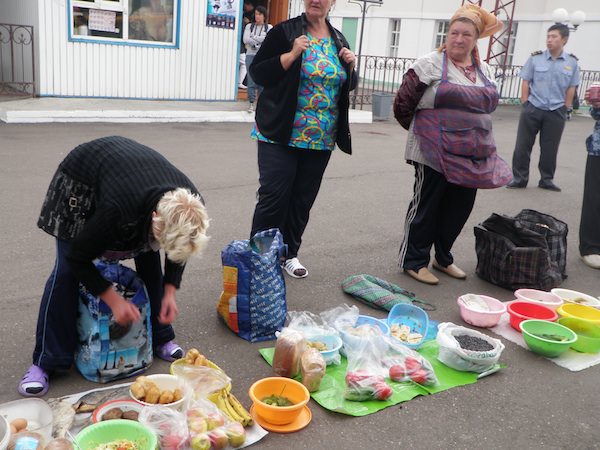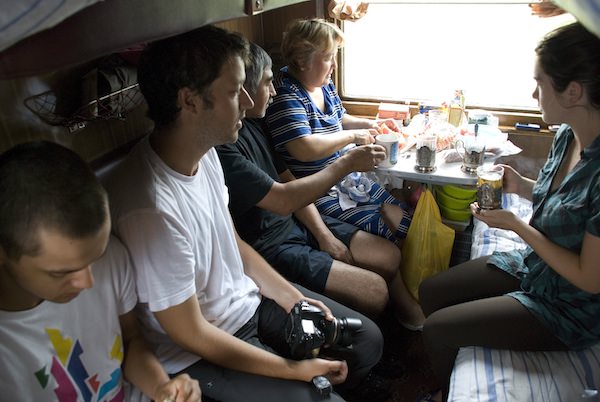This is the second of a series of articles offering advice and travel tips based on Caitlin Dwyer’s experience riding the Trans-Siberian Railway. See her first article, ‘Riding the Trans-Siberian Railway: Planning Your Journey‘. You may also be interested in a previous article: How to apply for a Russian Visa.
What exactly does a Trans-Siberian traveler need to take for a journey across Russia? Packing for a lengthy train journey is different than for most vacations: instead of bathing suits and beach towels, you may find yourself pondering the various flavors of Ramen noodles in the grocery store. To make the time on board pleasant and easy, travelers should plan details such as food, entertainment, and logistics ahead of time. A sensible packing list will ensure a safer and more comfortable journey.
Food:
- Tea or instant coffee
- Instant and dehydrated foods, such as noodles and beans
- A few fresh foods, such as cucumbers and tomatoes, which can be replenished at stops
- Vodka, cookies, or other treats for sharing around with your cabin mates
Every train car has a samovar – a large boiling pot of water. Mainly used to refill tea in endless quantities, the samovar is also a Trans-Siberian traveler’s best ally. Instant foods, such as potatoes, noodles, or rice dishes, can be safely and conveniently heated. These are the staples of a traveler’s cuisine because they can be easily carried and keep well over long distances.
The provinista, or train attendant, monitors the samovar; she can also provide dining utensils such as tea mugs, spoons, and napkins. Getting to know the provinista over the course of a journey may increase her willingness to lend out these items.
The train’s dining car has a wonderful old-world look to it – a curved bar at the front and booths with gilded lamps hung overhead. Heavy curtains over the windows give it a gloomy charm. However, the food tends to be greasy and overpriced; travelers shouldn’t count on eating all their meals there. On international routes, the dining car changes with each new country.
By the second or third day of a Trans-Siberian journey, most travelers no longer eat regular meals. Hours upon hours pass without much change, other than the occasional town rushing by; meals suddenly become rituals to mark the hours. Regular snacks make a good replacement for the structure of mealtimes.
On the platform at each stop, vendors spread their blankets and cover them in local delicacies: dried fish, pickles, apples, cucumbers, and beer. Train stops are more than a chance to stretch your legs; they provide the chance to restock your provisions.
Finally, if your taste inclines to it, bring a little nip of something to drink and share around with cabin-mates. This is a common way to make friends on the train.
Safety & Hygiene
- a watch or clock
- baby wipes or other clean-wipes
- slippers or flip-flops
- comfortable clothes
- seasonal attire (cold or warm weather) for stops
All trains run on Moscow time. The further the train gets from Moscow, the weirder this becomes – travelers begin to sleep according to the changing light, rather than the clock. Everyone starts to move in a half-daze, losing track of what day it is. A watch that can be reset through different time zones helps the body adjust.
First-class cars have a small shower, but second and third classes lack this luxury. To stay fresh on the train, bring baby wipes for a quick wipe-down in the evenings. In kupe class, travelers lack much privacy; four strangers share a compartment the size of a Chevy Suburban for multiple days. Maintaining hygiene and cleanliness within the cabin ensures a better journey for everyone.
On the train, most people wear comfortable clothes and rarely change except to disembark at stops. Inside, they wear slip-on shoes, such as flip-flop sandals or, in winter, warm slippers. Bring a pair of “train shoes” and avoid putting shod feet up on the lower bunks; these daytime seats become people’s beds at night.
Each car has luggage storage underneath the bottom bunks and also above them, in a narrow alcove. Anything stored under the bottom bunks will remain relatively unreachable during the journey, as these become the main seating area for passengers. Valuables should be kept discreetly. The best strategy to ensure the safety of your possessions is to make friends with fellow passengers, who can help look out for everyone’s belongings.
Logistics
- Russian language guide
- Lonely Planet “Trans-Siberian Railroad” or other guidebook
A guidebook which details the train itinerary (or a personal device with 3G, so you can track Europeupclose.com all across Siberia) will prove invaluable, especially for travelers who plan to get on and off the train. It also can provide the entertainment of identifying various landmarks, such as the continental crossing into Asia. There is no internet on the train and most Siberian towns will have patchy access.
For the Moscow-Vladivostok route, a Russian language guide will aid communication. Memorizing the Cyrillic alphabet – or having a book on hand – helps foreigners to sound out words phonetically. Most passengers on the train will speak limited English. On the international routes, English is spoken more widely.
Entertainment
- Mp3 or other music player
- That copy of War & Peace you’ve been meaning to read
- Notebook or sketchbook
The Trans-Siberians might be the ultimate chance to do nothing. The hours pass in peaceful contemplation of the countryside: leafy forests, houses with bright blue shutters, and occasionally an industrial city, rising with smoke and concrete from the banks of a river. For many travelers, the Trans-Siberian is a respite from the stress of travel. There are no hotels to book, no menus to master: just the adventure of coasting through some of the world’s most remote land.
Solitary leisure activities fill most travelers’ time. If War and Peace is too daunting, try works by some of the other great Russian writers: Anna Karenina, Crime & Punishment, Chekhov’s plays, or short stories by Gogol. For more modern tastes, Colin Thubron’s In Siberia makes a fascinating travel portrait of the passing landscape and the varied people that fill it.
Social interaction takes up the rest of the hours: playing cards, sharing meals. Each new station offers a chance for exploration, but enjoying train life can become a travel goal in and of itself.
Written by Caitlin Dwyer and photos by by Matt Bozigar for EuropeUpClose.com




Terri Fogarty
Saturday 8th of November 2014
The average high in February is 24F, so I would bundle up.
Grahame
Saturday 8th of November 2014
Lots of useful info, I'm hoping to make the journey from Vladivostok to UK in Feb 2015. So am reading up as much as possible. As this will be a one off will it be worth my while to buy good quality boots / coat for those stops where I can get off and stretch my legs? I will have scarf, mittens. Am I right to think that it is quieter at that time of year?
Kokomplokos
Sunday 26th of May 2013
Are there any power outlets for charging up a laptop or any portable device (camera, mp3 player, etc)?
National Visas
Wednesday 13th of June 2012
Exactly what I need to know. I'll be having a trip there these July and thanks for sharing some tips here. It helps a lot for me.
Fiona Cope
Sunday 25th of March 2012
Well, this is where the family is traveling this summer. Better to be prepared....